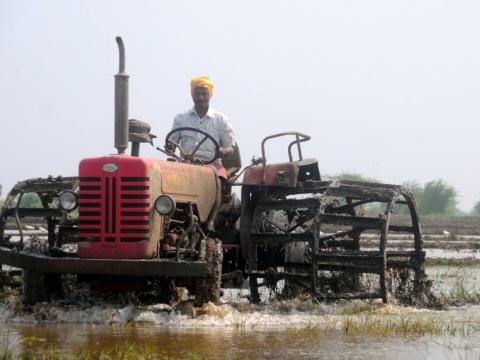Transforming Salty Land into Flourishing Fields

During the days, weeks and months that followed the devastating tsunami, World Vision India had already started reaching out with food, water, dry rations, medical aid, temporary shelters and other forms of assistance, serving thousands of people, mostly fishermen from villages along the coast.
While all the international aid and assistance was being poured into rebuilding the lives of fishermen who were some of the worst affected, not many organisations noticed the hundreds of farmers whose lands got flooded with the salt water from the sea, leaving the land unusable for many years to come.
The massive tsunami waves had flushed thousands of litres of sea water into the canals and streams used for cultivation, turning the land saline. More than 300 acres of agricultural land was salinated in Picchavaram alone, a district about 30 kms from the coastal district of Cuddalore.
“All of a sudden not only had we lost one whole year’s yield of paddy, but were also left with a land that would be unusable for the next 20 or more years,” said Kannan, the leader of the farmers’ association in Picchavaram.
World Vision decided to help the over 400 farmers, who were completely dependent on these lands for their livelihood. Using the cash-for-work model, World Vision started the laborious task of desalinating the farmlands. A lot of clean water was pumped onto the lands and was let to soak for a few days, then the whole field was ploughed, a lot of fertilizer was added and then more clean water was pumped in. This process went on for many days and in a few weeks, more than 330 acres of agricultural land was ready for cultivation.
But the two things that made the biggest impact in our village were; during the cash-for-work program, World Vision insisted that they would give equal wages to both the men and women who were involved.
“World Vision was the only organisation that came and helped us. And they did not stop with just desalinating the land. They stood by us, until we got our first harvest after the tsunami,” says Kannan.
“We had lost all the crops and couldn’t even buy seeds, so World Vision bought seeds also for us to start cultivation again. We will always be grateful for their help during that time,” he adds. World Vision also gave two tractors, each worth over Rs.250,000 (approx $4000 USD).
“But the two things that made the biggest impact in our village were; during the cash-for-work program, World Vision insisted that they would give equal wages to both the men and women who were involved. Before that, anywhere we worked women would get paid a little less than the men,” says Paulraj, a local leader and farmer. “This actually changed our mindset and we realised that men and women should be treated equal when they do the same amount of work,” he adds.
“The second biggest impact was that World Vision built toilets in our village. No one in the village had ever used a toilet before that. Today every single home has a toilet,” adds Paulraj, evidently very proud of the progress his village had made.
World Vision also brought in agricultural experts and taught the farmers agricultural methods and practices that would give them a better yield. They were taught how to divide the land into smaller sections in order to control pests better and make sowing of seeds and spraying of pesticides uniform and more effective. They were also taught how to use more natural pesticides using Neem leaves and other natural resources, therefore reducing chemicals in the whole process of cultivation.
The season of harvest that followed after the desalination of the agricultural lands was one of the biggest yields that the farmers had ever harvested.
“We would usually harvest around 18 bags per acre. But that year we got around 20 to 25 bags per acre,” says Kannan. “We were able to get a bigger harvest than we used to, only because of World Vision,” he adds.